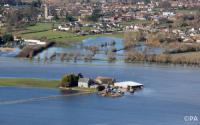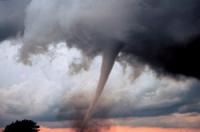-
Mass trauma’s emotional toll can disrupt children’s sense of competence
Traumatic events can have a profound effect on communities. Whether it is a terrorist attack or a natural disaster, such as a hurricane or tornado, the aftermath can have lasting effects, especially on children. How children respond in the wake of mass traumatic events is related to their perceptions of competence – or how they view their ability to control a situation. An overwhelming challenge, such as a natural disaster or a terrorist attack, can disrupt the development of that sense of well-being.
-
-
Frequency of coastal flooding will double globally in next decades

The frequency and severity of coastal flooding throughout the world will increase rapidly and eventually double in frequency over the coming decades even with only moderate amounts of sea level rise, according to a new study. The new report shows that with just 10 to 20 cm (4 to 8 inches) of sea level rise expected no later than 2050, coastal flooding will more than double. This dramatic increase in coastal flooding results from rising sea levels combined with storm-driven flooding, including the effects of waves and storm surge.
-
-
No funds for California's earthquake early-warning system in Trump's proposed budget
The Trump administration’s proposed budget would eliminate federal funding for an earthquake early warning system being developed for the U.S. West Coast. Critics say that if the relevant clauses in the budget proposal become law, the long-planned seismic warning effort will be killed. Scientists say the withdrawal of federal funds would likely end the early-warning project, which aims to send smartphone tremor alert messages to West Coast residents.
-
-
Israel to install earthquake early-warning system
Israel has selected Ottawa, Canada-based Nanometrics to build an earthquake early-warning system in Israel. The alert system will give a 10-to-30-second alert of an impending earthquake. The system’s success depends on the distinction between two types of waves an earthquake generates — P waves (for primary) and S waves (for secondary). P waves are very fast, traveling through rock at between four and seven kilometers per second, and are thus the first waves to arrive at a recording station following an earthquake. An S-wave has a shearing motion that makes the rock vibrate perpendicular to its path. This movement slows the S-wave, so that it travels at two to five kilometers per second, or about half the speed of the P-wave. It is S waves which are almost entirely responsible for the damage and destruction associated with earthquakes.
-
-
Drones help in better understanding of wildfires
U.S. Geological Survey scientists and partners are taking technology to the next level, using unmanned aircraft systems (UAS) to acquire both fire intensity and emissions data during prescribed burns. This effort combines expertise from multiple USGS partners that could reduce the harmful effects of smoke impacts from use of prescribed burns. Lessening the risk to property and lives during wildfires is a primary purpose of prescribed burns.
-
-
Knowing more and loosing less: Science and helps in disaster risk management
Natural and man-made disasters threaten millions of people every year and cause billions of property damage. How much do we know about them? And how can we use that knowledge to save lives and money? A recent report —Science for Disaster Risk Management 2017: Knowing More and Losing Less — seeks to answer these and other questions and to help prepare for the time when disaster strikes.
-
-
Weather disaster-prone countries do not spend more on weather services
Countries hit hardest by weather-related disasters do not necessarily spend more on commercial weather and climate information services that assist in preparing for these events, a new study finds. Identifying countries for which this is true and improving the design and delivery of weather and climate services in these locations could lead to better decision-making regarding risks and challenges, ultimately helping to save lives, protect infrastructure, and move people out of poverty.
-
-
Climate change likely to increase risk of costly storms in U.K.
The impact of climate change on the United Kingdom is likely to mean a higher number of more expensive wind storms, the insurance industry warned. New analysis done for the Association of British Insurers (ABI) shows temperature increases of just a small number of degrees are likely to lead to insurance losses for high winds which could be 11 percent, 23 percent, or even 25 percent higher nationwide.
-
-
Tornado’s strength explains number of casualties more than number of people in twister’s way
New research shows that the strength of a tornado has a significantly larger effect than population on the number of casualties. Using a regression model, researchers found that on average a doubling of the population under the path of a tornado leads to a 21 percent increase in the casualty rate, while a doubling of the energy dispersed by the tornado leads to a 33 percent increase in the casualty rate.
-
-
Creating high-speed internet lane for emergency situations
In a disaster, a delay can mean the difference between life and death. Emergency responders don’t have time to wait in traffic — even on the congested information superhighway. Researchers are developing a faster and more reliable way to send and receive large amounts of data through the internet. By a creating a new network protocol, called Multi Node Label Routing protocol, researchers are essentially developing a new high-speed lane of online traffic, specifically for emergency information.
-
-
AI to aid in humanitarian efforts
Mobile phones are one of the fastest growing technologies in the developing world with global penetration rates reaching 90 percent. However, the fact that most phones in developing countries are pre-paid means that the data lacks key information about the person carrying the phone, including gender and other demographic data, which could be useful in a crisis. Researchers have developed an AI algorithm to accurately predict the gender of pre-paid mobile phone users, so that emergency response teams would have better information about those affected by disasters.
-
-
Tornado damage impact could triple in coming decades

Tornadoes are one of the most unpredictable weather phenomena on Earth. Each year the United States, home to more tornadoes than any other country, sustains billions of dollars of damage, death, injuries, and disruption from the violent storms. Scientists say that the potential for annual tornado impact magnitude and disaster could triple by the end of the twenty-first century.
-
-
New tool could help predict, prevent surging waters in flood plains
A group of international scientists studying China’s Yellow River has created a new tool that could help officials better predict and prevent its all-too-frequent floods, which threaten as many as eighty million people. The tool — a formula to calculate sediment transport — may also be applied to studying the sustainability of eroding coastlines worldwide.
-
-
Tipping points: When natural or social systems reach a point of no return
A tipping point is a critical threshold at which a dynamical system undergoes an irreversible transformation, typically owing to a small change in inputs or parameters. This concept is very broad and can refer to the extinction of an animal or a plant species, the depletion of a water source, or the financial collapse of an institution, among many other natural and social phenomena. Researchers provide a better understanding of the characteristics of this point of no return and what happens to a system after its occurrence.
-
-
Helping power utilities and others better plan for the future
If you’re an electric utility planning a new power plant by a river, it would be nice to know what that river will look like twenty years down the road. Will it be so high that it might flood the new facility? Will the water be so low that it can’t be used to cool the plant? Generally, such projections have been based on records of past precipitation, temperature, flooding and other historical data. But in an era when temperature and precipitation are changing rapidly, historical patterns won’t do you much good. A new initiative by the U.S. Department of Energy’s (DOE) Argonne National Laboratory combines climate data and analysis with infrastructure planning and decision support, promises real help.
-
More headlines
The long view
The Surprising Reasons Floods and Other Disasters Are Deadlier at Night
It’s not just that it’s dark and people are asleep. Urban sprawl, confirmation bias, and other factors can play a role.
Why Flash Flood Warnings Will Continue to Go Unheeded
Experts say local education and community support are key to conveying risk.
